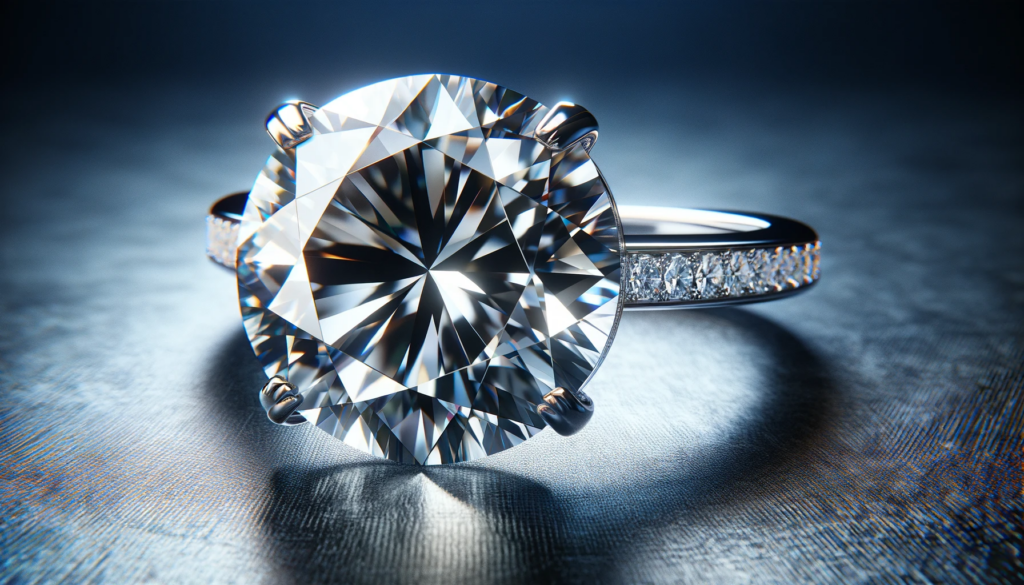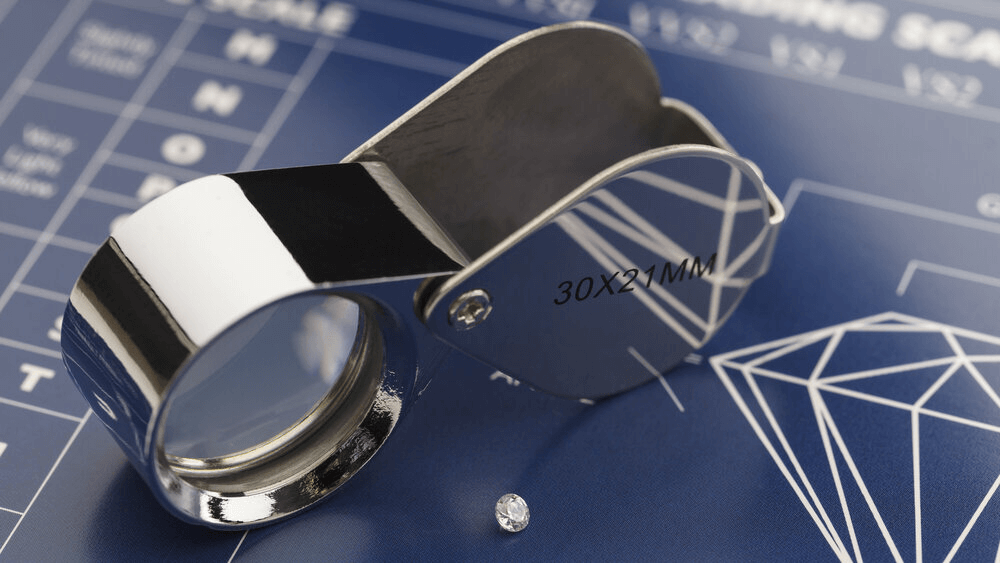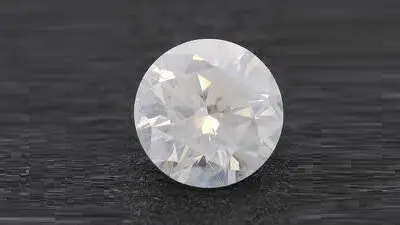Why Flawless Diamonds Are Not Worth the Hype

By Gary A.

Edited by Olivia H.
Published Sep 9, 2021
Edited on Mar 31, 2025
Flawless diamonds represent the pinnacle of perfection, offering unmatched clarity and rarity for those who seek nothing but the best. Explore our guide to flawless diamond engagement rings and uncover how to make the ultimate statement of love and luxury.

Navigate This Guide:
- 6 Quick Tips for Buying a Flawless Diamond Engagement Ring
- Introduction
- Understanding Flawless Diamonds
- The Art of Diamond Valuation
- Our Expert Take
- 10 FAQs
Before we dive deeper into the specifics, here are some practical tips to help guide your decision-making process:
6 Quick Tips for Buying a Flawless Diamond Engagement Ring
When embarking on the journey to purchase a flawless diamond (FL) or internally flawless (IF) engagement ring, several practical aspects must be considered. These tips will guide you in making an informed decision, focusing specifically on the clarity of FL-IF diamonds.
- Tip 1: Understand the 10X Magnification Standard Tip: Get familiar with the 10X magnification standard used in grading FL-IF diamonds. Although these diamonds are graded for no visible inclusions at this magnification, understanding what this looks like can help set realistic expectations.
- Tip 2: Examine the Diamond Under Various Light Conditions Tip: Observe the diamond under different lighting conditions. Even though FL-IF diamonds are known for their clarity, their appearance can change slightly under various light sources. This examination can reveal subtle characteristics that influence the diamond’s brilliance and overall appeal.
- Tip 3: Be Mindful of the Cut Quality Tip: Pay close attention to the diamond’s cut quality. A high-quality cut enhances the diamond’s inherent clarity, especially in FL-IF grades, maximizing sparkle and visual impact. Remember, the cut can influence how inclusions, if any, are perceived.
- Tip 4: Consider Carat Weight and Size Implications Tip: Balance the diamond’s carat weight with clarity. Larger FL-IF diamonds are rarer and more expensive. If size is a priority, consider slightly lower carat weights within the FL-IF range to find a balance between size and cost.
- Tip 5: Evaluate the Diamond’s Setting Potential Tip: Assess how the diamond will look in its setting. The ring’s design can impact how the diamond’s clarity is showcased. Some settings might enhance the visual purity of FL-IF diamonds, while others might not make significant use of their high clarity.
- Tip 6: Be Aware of the Pricing Premium Tip: Be conscious of the premium pricing of FL-IF diamonds. Understand that you’re paying for rarity and perfection as perceived under magnification. Knowing this, evaluate if the premium aligns with your personal value and budget for the ring.
Now that you’ve got these practical tips, use Jeweler AI below to find the perfect engagement ring that suits your style and budget:
Introduction
You don’t need us to tell you that finding the perfect diamond engagement ring is not always a walk in the park and that plenty of people have fallen afoul of ‘buyers’ doubt’ during their own searches. An investment this big requires you to follow your own instincts – to know your partner better, maybe, than she knows herself – but it also requires plenty of research, and the ability to follow fact as much as fancy.
What we mean by ‘the facts’ is, of course, the objective information available on any GIA certified diamond in existence: cut, color, clarity and carat. These four Cs offer a clear snapshot of the ring, its quality and, by extension, its value.
Still, it’s easy to take these Cs a little too literally, and all too common for new shoppers to jump to the conclusion that simply targeting the very top grades for clarity and color is a foolproof tactic for making a good investment.
So, is the ‘most beautiful’ diamond the wisest choice for your future bride? Chances are the answer is no. Here’s why.

Understanding Flawless Diamonds
Meaning ‘Flawless’, FL is the uppermost grade for clarity on the GIA Scale. It refers to a diamond, under 10x magnification, and does not hold any visible inclusions.
These diamonds, along with Type IIa diamonds, are also the rarest since it is incredibly rare for nature to produce something so close to perfection as an FL diamond.
FL diamonds will still have inclusions visible only under extreme magnification – say, 100x – but gemologists only go as far as 10x magnification for grading clarity. They are highly popular among the world’s most avid collectors of diamonds, and so, for that reason, are not something that the casual shopper will see listed for sale.
On the global diamond market, a slightly more common sight is the IF Diamond grade, but even that one is hard to come by.
Characteristics of FL and IF Diamonds
Fewer than 0.5% of all diamonds are graded at FL. While the microscopic beauty of an FL graded diamond is highly valued among collectors, it is undoubtedly their rarity that makes them so valuable.
Why? Because, as we mentioned, many diamonds appear as free from flaws as FL diamonds, so the aesthetic benefits of paying many thousands of dollars for these stones is insignificant. For those who are willing to invest, the allure of FL diamonds primarily stems from the fact that they are highly unlikely phenomena, and one of just a small few in the world today.
As you’d expect, FL and IF diamonds also appear very bright, very clear and crisp, with no visible inclusions or blemishes. They are, in a word, perfection.
Here’s the rub: flawless diamonds will look identical to eye clean diamonds with lower clarity grades unless you’re scrutinizing them through a microscope.
By far the most important factor impacting sparkle is cut. Some cuts sparkle more than others, with the 58-faceted round cut stealing the show in terms of sparkle.
Clarity can impact sparkle, but only when a diamond’s clarity is so low that it features significant and visible inclusions. For instance, cloudy diamonds are considered highly undesirable for jewelry because of the fact that their inclusions prevent them from sparkling – and, instead, they look pretty lackluster.
But, as we’ve mentioned above, many diamonds – even those that are several grades away from Flawless – appear eye clean, or have only the most minor inclusions, and they will sparkle just as beautifully as a diamond that is free from inclusions.
Flawless and Internally Flawless Diamonds vs VVS Diamonds
A clarity grade of FL is objectively better than VVS, since the former holds no inclusions – but, visually, they will look the same.
Clarity is decided under a microscope, and only at the lower end of the GIA Clarity Scale will you find diamonds that are visibly included. The rest, while included, appear to be free from any imperfections when viewed with the naked eye. The only noticeable difference between FL and VVS – provided you don’t have a microscope to hand – is the price tag.
Put it this way. The GIA Clarity scale runs from FL and IF, through VVS1 and VVS2, VS1 and VS2, SI1 and SI2, and I1, I2 and I3.
It is possible to find eye clean diamonds graded as (seemingly) low as SI1 – and that’s six grades below the perfection of an FL grade.
So, if you’re looking for an eye clean diamond, you can afford to stray much further from FL than you might realize – and save yourself thousands of dollars in the process. And, while FL is demonstrably ‘better’ than VVS (or any other grade on the GIA Scale, for that matter) it’s not the best choice for you, or your bride-to-be.
The Art of Diamond Valuation
It won’t come as a surprise to know that FL and IF diamonds are very expensive. Their value is significantly higher than that of the next diamond clarity grade down (VVS1), although this price hike is due primarily to their rarity, rather than their physical appearance to the naked eye.
Pricing Dynamics of Flawless Diamonds
A 1 carat FL diamond with excellent cut and color grades will likely cost upwards of $10,000, with the price rising exponentially with carat weight. A color D flawless diamond will be worth thousands more than a diamond with a slightly lesser color and clarity grade, but you won’t get any more visual quality, despite the extra investment.
At smaller sizes (around 1 carat) the cost of a flawless diamond can be more than a third higher than the cost of a VVS diamond with a comparable carat weight, cut and color. At higher carat weights, the price can quickly escalate into five – or even six – figures, simply because the FL and IF grades are so highly coveted among collectors.
As a result, these diamonds are not intended to be purchased by those looking to find a center stone for an engagement ring. In fact, while diamond is an incredibly strong substance, it will quickly lose its status as ‘Flawless’ when mounted within jewelry, since even the most minor blemishes (surface flaws) will occur during this process, and during wear.
Comparison: FL vs IF Diamonds
There really is the smallest difference between an FL and an IF diamond. Let’s put it this way: you wouldn’t be able to tell the difference between an IF and an eye clean SI1 diamond, which puts the idea of spotting the difference between FL and IF diamonds even further out of reach.
As an investment, IF makes more sense simply because it’s slightly cheaper than FL, but neither one is a good investment – particularly for an engagement ring.
Our Expert Take
Do you need a flawless clarity diamond? No. Will you even find many flawless diamonds for sale? Again, no, because flawlessness is one of the rarest phenomena found in nature, and collectors are willing to pay above and beyond the usual cost of a 1, 5, or 10 carat diamond just to hold that perfection in their hand.
Even a 1 carat flawless diamond will be way out of the average shopper’s price range – and, if it’s not, why not spend that money on getting a bigger diamond, or one with a better color? Flawlessness is only impressive under a microscope, and how often will you find your high-price-tag flawless diamond engagement ring in the lab after you propose?
10 FAQs
- Q: What Makes a Diamond “Flawless?
- A: A flawless diamond has no visible inclusions or blemishes when viewed under 10x magnification. It’s the highest clarity grade a diamond can receive.
- Q: How Rare Are Flawless Diamonds?
- A: Extremely rare. Less than 1% of diamonds mined are classified as flawless, making them highly sought-after and valuable.
- Q: Is There a Big Difference Between FL and IF Diamonds?
- A: The difference is subtle. FL (Flawless) diamonds have no inclusions or blemishes, while IF (Internally Flawless) diamonds may have minor surface blemishes.
- Q: Does a Flawless Diamond Sparkle More?
- A: Not necessarily. While clarity is important, a diamond’s sparkle is more influenced by its cut quality.
- Q: Are Flawless Diamonds a Good Investment?
- A: Yes, due to their rarity, flawless diamonds can be a good investment. However, market trends should always be considered.
- Q: How Much Do Flawless Diamonds Cost?
- A: The cost varies greatly based on size, color, and other factors. Flawless diamonds are premium-priced due to their rarity.
- Q: Can You See the Difference Between a Flawless and a Slightly Included Diamond?
- A: With the naked eye, it’s often difficult to distinguish between a flawless diamond and one with minor inclusions.
- Q: Should I Choose a Flawless Diamond for an Engagement Ring?
- A: It depends on your budget and preferences. While flawless diamonds are prestigious, lower clarity grades can also offer beauty and value.
- Q: How Do I Verify a Diamond’s Flawlessness?
- A: Through a certificate from a reputable gemological lab like the GIA, which provides detailed information about the diamond’s clarity.
- Q: Are Flawless Diamonds Always Colorless?
- A: Not necessarily. Diamonds can be flawless but still have color. Color and clarity are graded separately.
Discover your perfect ring with Jeweler AI – your gateway to the world of flawless diamonds
FOLLOW-UP GUIDE SERIES





















